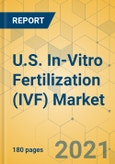Speak directly to the analyst to clarify any post sales queries you may have.
The U.S. in-vitro fertilization market by revenue is expected to grow at a CAGR of 5.45% during the period 2021-2026.
U.S. IN-VITRO FERTILIZATION INDUSTRY INSIGHTS
Over the past few years, the infertility treatment market has been growing at a healthy rate because of rising awareness regarding the availability of various infertility treatment options through the government. Vendors advocating IVF awareness and campaigns are increasing the acceptance of IVF procedures and a surge in fertility tourism, which boosts the growth of the U.S. IVF market. Technological advancements and innovations are being majorly focused on by the fertility clinics and fertility treatment centers to improve the treatment outcomes, surging the growth of the IVF market. Some modern in-vitro fertilization technologies are assisted hatching, Cult-Active, EmbryoGen, Embryo glue, and Intracytoplasmic sperm injection. Investors are purchasing and acquiring fertility clinics with a high success rate of fertility treatment. New investors are discovering the attractiveness of infertility treatment after seeing the success of recent investments and establishing fertility clinics with sophisticated infrastructure.
The following factors are likely to contribute to the growth of the U.S. in-vitro fertilization market during the forecast period:
- Technological Advancements & Innovations in IVF
- Increasing Private Equity/Venture Capital Funding in IVF Clinics
- Rising Number of Obesity Cases
- Increasing Number of Fertility Clinics Offering Fertility Services
The study considers the present scenario of the U.S. In-vitro fertilization market and its market dynamics for the period 2020−2026. It covers a detailed overview of several market growth enablers, restraints, and trends.
The report offers both the demand and supply aspects of the market. It profiles and examines leading companies and other prominent ones operating in the market.
KEY HIGHLIGHTS
- The consumables segment is likely to witness the highest absolute growth of 43.16% in the U.S. in-vitro fertilization (IVF) market during the forecast period compared to media and equipment product segments.
- As the market is witnessing the increased demand for infertility treatments, this created huge competition among the vendors to offer a wide range of innovative media, consumables, and the devices necessary for infertility treatment.
- Japan, India, and the U.S. have a greater number of in-vitro fertilization clinics compared to other countries.
SEGMENTATION ANALYSIS
The U.S. in-vitro fertilization market research report will include in-depth coverage of the industry analysis with revenue and forecast insights for the following segments:
Segmentation by Products
- Consumables
- Media
- Equipment
Segmentation by End-Users
- Fertility Clinics
- Hospitals
- Others
Segmentation by Donor Type
- Fresh Non-Donor
- Frozen Non-Donor
- Fresh Donor
- Frozen Donor
VENDOR LANDSCAPE
The US in-vitro fertilization market is characterized by the presence of global, regional, and local vendors. In recent years, the global infertility treatment market has witnessed many strategic initiatives by key vendors, which is expected to intensify market competitiveness in the upcoming years. Infertility treatment is a niche industry with high margins for manufacturers, especially for vendors offering equipment, media, and related consumables, that are widely used during ART procedures. Players are expected to have active participation in the U.S. in-vitro fertilization market to maximize profit.
Prominent Vendors
- The Cooper Companies
- Cook Medical
- Vitrolife
- FUJIFILM Irvine Scientific
- Merck Group
- Hamilton Thorne
Other Prominent Vendors
- CARL ZEISS
- Kitazato USA
- Rocket Medical
- Thermo Fisher Scientific
- Thomas Medical
- Nidacon
- Esco Lifesciences
- GYNEMED
KEY QUESTIONS ANSWERED:
1. How big is the U.S. IVF market?
2. What is the growth rate of the US in vitro fertilization (IVF) market?
3. Which segment accounted for the largest in-vitro fertilization market share?
4. Who are the key players in the US in-vitro fertilization market?
5. What are some of the technological advancements and innovations in the IVF market?
Table of Contents
Companies Mentioned
- The Cooper Companies
- Cook Medical
- Vitrolife
- FUJIFILM Irvine Scientific
- Merck Group
- Hamilton Thorne
- CARL ZEISS
- Kitazato USA
- Rocket Medical
- Thermo Fisher Scientific
- Thomas Medical
- Nidacon
- Esco Lifesciences
- GYNEMED
Methodology
Our research comprises a mix of primary and secondary research. The secondary research sources that are typically referred to include, but are not limited to, company websites, annual reports, financial reports, company pipeline charts, broker reports, investor presentations and SEC filings, journals and conferences, internal proprietary databases, news articles, press releases, and webcasts specific to the companies operating in any given market.
Primary research involves email interactions with the industry participants across major geographies. The participants who typically take part in such a process include, but are not limited to, CEOs, VPs, business development managers, market intelligence managers, and national sales managers. We primarily rely on internal research work and internal databases that we have populated over the years. We cross-verify our secondary research findings with the primary respondents participating in the study.

LOADING...








